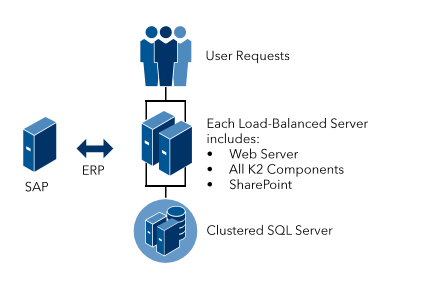Supported Topologies
K2 connect for SAP is an add on component to K2 Five. K2 connect is installed along side supported K2 Five installations, which may be standalone, distributed or NLB environments. See the K2 Five supported topologies topic for more information. Before starting your installation of K2, make sure you understand these supported topologies and how they map to your own environment.
| Deployment Options | |
|---|---|
|
Standalone or Small scale Installation |
This installation would be installed on an existing K2 Server along with the Client and Administration tools. The Database components may be installed on an independent SQL server machine. |
|
Scaling For Data Availability |
The K2 connect Server is installed on an existing K2 Five Server, the Client and Administration tools are distributed onto independent physical servers. |
|
Scaling for Availability and Performance |
The K2 connect Server is added to the existing architecture where a K2 Five NLB environment exists already. Each K2 Five Server requires an individual installation of the K2 connect Service and an individual license as well. |
Regardless of the configuration chosen, the K2 connect for SAP service is always installed on the same physical machine as the K2 Five Server
Standalone means that all the K2 components are installed on the same server or machine. SAP itself would most likely be located on its own server machine.
Standalone installations are better suited for low-load environments, like project development or staging environments. Since all components are installed on the same physical server as the K2 Server, there are no credentials passed between servers except for when credentials are passed to SAP.
| Standalone Install | |
|---|---|
|
Server A |
K2 Five (all components) |
|
SAP Server |
SAP Server and associated applications. For the supported version(s), see the Software prerequisites section. |
The Standalone Installation configuration for K2 connect is shown below. All K2 components, IIS, SharePoint, K2 connect for SAP and the database instance are installed on the same physical platform. The SQL Server may be a separate machine and installation to that machine is seamless. SAP would be installed as a separate instance, on an independent machine.

Considerations for the Standalone Install
Because all K2 Five and K2 connect for SAP components are installed on a single standalone server, this system may experience performance issues if multiple developers utilize this machine to access deployed service objects.
Hardware
If this installation scenario is used for a development or staging environment, we recommend that additional RAM and a faster processor is used to maintain an acceptable level of performance.
In many cases K2 connect is installed on existing infrastructure, and the database components can easily be installed on an existing SQL server. This is true even when all K2 components are installed on an existing server. This is suitable for small usage, such as a test or training environment.
| Small Scale Install | |
|---|---|
| Server A |
K2 Five (all components) |
| Server B | SQL Server |
| SAP Server | SAP Server and associated applications. For the supported version(s), see the Software prerequisites section. |
The Small Scale Install configuration for K2 connect for SAP is shown below. All K2 components including IIS, SQL Reporting Services, and SharePoint are installed on one server, and the databases are located on a separate server.

This scenario is better suited for small organizations that do not require any redundancy. To enable the support of an increasing load on the K2 infrastructure, the K2 Server is separated from the SharePoint server for scalability.
| Scaling for Better Performance Install | |
|---|---|
| Server A | SharePoint |
| Server B | K2 Five (all components) Internet Information Server (IIS) K2 connect for SAP |
| Server C | SQL Server |
| SAP Server | SAP Line of Business Server and associated Applications. For the supported version(s), see the Software prerequisites section. |
The Scaling for Better Performance scenario is shown below. All of the K2 Five components are separated out from the SharePoint components, with a separate SQL server.

Both the Scaling for Page Rendering and Scaling for Data Availability scenarios introduce redundancy into the system. This scenario addresses both the data availability, by adding a SQL cluster into the infrastructure, as well as fail over via load balancing on the other components.
| Scaling for Data Availability and Performance | |
|---|---|
| Server A | NLB SharePoint and IIS |
| Server B | NLB K2 Five (all components) K2 connect for SAP |
| Server C, D | Clustered SQL Server |
| SAP | SAP Line of Business Server and associated Applications. For the supported version(s), see the Software prerequisites section. |
In the figure below, the Scaling for Data Availability and Performance scenario is shown. There is a SQL cluster, and all IIS, SharePoint, SQL Reporting Services, and K2 components are on an NLB cluster.
